
WrestleMania IV was the fourth annual WrestleMania professional wrestling pay-per-view (PPV) event produced by the World Wrestling Federation. The event took place on March 27, 1988, at Boardwalk Hall in Atlantic City, New Jersey. The announced attendance of the event was 19,199, drawing a 6.5 buyrate on PPV.
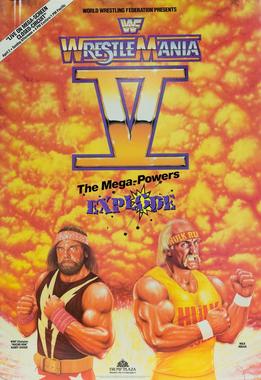
WrestleMania V was the fifth annual WrestleMania professional wrestling pay-per-view (PPV) event produced by the World Wrestling Federation. It took place on April 2, 1989, at the Boardwalk Hall in Atlantic City, New Jersey. A total of 14 matches were contested at the event.

WrestleMania VI was the sixth annual WrestleMania professional wrestling pay-per-view (PPV) event produced by the World Wrestling Federation. It took place on April 1, 1990, at the SkyDome in Toronto, Ontario, Canada, marking the first WrestleMania to be held outside of the United States. The event had an announced attendance of 67,678, a record for the Skydome at the time. The main event of WrestleMania VI was "the Ultimate Challenge" — the main event match pitting WWF Champion Hulk Hogan against WWF Intercontinental Heavyweight Champion the Ultimate Warrior.

WrestleMania IX was the ninth annual WrestleMania professional wrestling pay-per-view (PPV) event produced by the World Wrestling Federation. The event took place on April 4, 1993, at Caesars Palace in the Las Vegas suburb of Paradise, Nevada. It was the first WrestleMania event held outdoors.

James Edward Duggan Jr., better known by his ring name "Hacksaw" Jim Duggan, is an American retired professional wrestler. His best-known character is a patriot who swings a 2x4 at opponents, cries "Hoooooo!" continually with a thumbs up and leads chants of U-S-A!

James Morris is an American retired professional wrestler and current radio host, better known by his ring name, Hillbilly Jim. He is best known for his appearances with the World Wrestling Federation (WWF) from 1984 to 1991, and in the series Hillbilly Moments.

Adolfo Bresciano was an Italian-Canadian professional wrestler and promoter, better known by the ring name Dino Bravo.
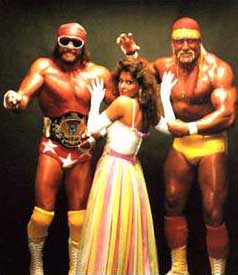
The Mega Powers was a tag team in the World Wrestling Federation (WWF) from 1987 to 1989, consisting of Hulk Hogan and Randy Savage, and managed by Savage's wife, Miss Elizabeth. Lust and jealousy surrounding her led to the team's demise and subsequent feud, culminating in a match at WrestleMania V. They briefly reformed in World Championship Wrestling (WCW) in 1994 as The Monster Maniacs before returning to their original name. They then interacted regularly thereafter as both teammates and rivals, particularly as members of the New World Order (nWo), until their departures from WCW in 2000.

The Dream Team was a World Wrestling Federation tag team from 1985 to March 29, 1987 consisting of Brutus Beefcake and Greg Valentine managed by "Luscious" Johnny Valiant. The New Dream Team, also managed by Johnny Valiant, saw Dino Bravo replace Brutus Beefcake and competed from March 1987 until the winter of 1988.

The 1988 SummerSlam was the inaugural SummerSlam professional wrestling pay-per-view (PPV) event produced by the World Wrestling Federation. It took place on August 29, 1988, at Madison Square Garden in New York City, New York. The pay-per-view was created to help the company compete against rival promotion Jim Crockett Promotions. It was one of the first four annual pay-per-view events produced by the WWF, along with WrestleMania, the Royal Rumble, and Survivor Series, which were eventually dubbed the "big four".
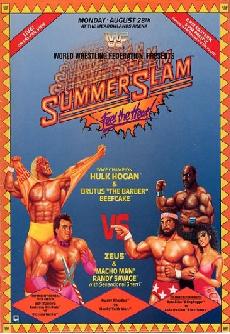
The 1989 SummerSlam was the second annual SummerSlam professional wrestling pay-per-view (PPV) event produced by the World Wrestling Federation. It took place on August 28, 1989, in the Meadowlands Arena in East Rutherford, New Jersey. Ten matches were contested at the event, including one dark match held before the live broadcast.

The 1990 SummerSlam was the third annual SummerSlam professional wrestling pay-per-view event produced by the World Wrestling Federation. It took place on August 27, 1990, at The Spectrum in Philadelphia, Pennsylvania. The card consisted of 10 televised matches, including two main events. The Ultimate Warrior successfully defended the WWF World Heavyweight Championship against Rick Rude in a Steel Cage match, and Hulk Hogan defeated Earthquake by countout.

The 1988 Royal Rumble was the inaugural Royal Rumble professional wrestling event produced by the World Wrestling Federation. It took place on January 24, 1988, at the Copps Coliseum in Hamilton, Ontario, Canada. The event aired as a television special on the USA Network on the same night as Jim Crockett Promotions' Bunkhouse Stampede pay-per-view (PPV) and was centered on the Royal Rumble match, a modified battle royal in which participants enter at timed intervals instead of all beginning in the ring at the same time. It would be the only Royal Rumble event to broadcast as a television special, as beginning with the 1989 event, it began airing on pay-per-view. After the launch of the WWE Network in 2014, this inaugural Royal Rumble was included with the rest of the Royal Rumble events in the PPV section.

The 1993 Royal Rumble was the sixth annual Royal Rumble professional wrestling pay-per-view (PPV) event produced by the World Wrestling Federation. It took place on January 24, 1993, at the ARCO Arena in Sacramento, California. It centered on the Royal Rumble match, a modified battle royal in which participants enter at timed intervals instead of all beginning in the ring at the same time.

The 1990 Royal Rumble was the third annual Royal Rumble professional wrestling pay-per-view (PPV) event produced by the World Wrestling Federation. It took place on January 21, 1990, at the Orlando Arena in Orlando, Florida. It centered on the Royal Rumble match, a modified battle royal in which participants enter at timed intervals instead of all beginning in the ring at the same time.

The 1987 Survivor Series was the inaugural Survivor Series professional wrestling pay-per-view (PPV) event produced by the World Wrestling Federation. It took place on Thanksgiving Night on November 26, 1987, and was held at the Richfield Coliseum in Richfield Township, Ohio. It was one of the first four annual pay-per-view events produced by the WWF, along with WrestleMania introduced in 1985 and Royal Rumble and SummerSlam introduced in 1988, referred to as the "Big Four".
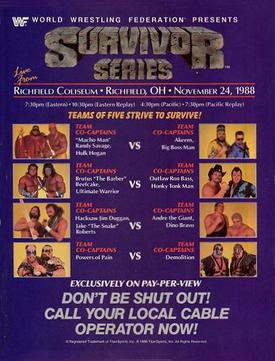
The 1988 Survivor Series was the second annual Survivor Series professional wrestling pay-per-view (PPV) event produced by the World Wrestling Federation. It took place on November 24, 1988, at the Richfield Coliseum, in Richfield Township, Ohio for the second consecutive year. Four matches were contested at the event.
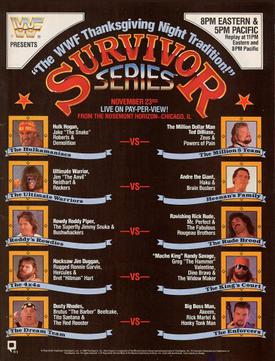
The 1989 Survivor Series was the third annual Survivor Series professional wrestling pay-per-view (PPV) event produced by the World Wrestling Federation. It took place on Thanksgiving Day on November 23, 1989, at the Rosemont Horizon in the Chicago suburb of Rosemont, Illinois.
The Twin Towers were a professional wrestling tag team in the World Wrestling Federation (WWF) from 1988 to 1990, consisting of Akeem and the Big Boss Man. They are best known for a main event feud with the Mega Powers.

No Holds Barred: The Match/The Movie was a professional wrestling pay-per-view (PPV) event produced by the World Wrestling Federation. The program aired on December 27, 1989, and consisted of the film No Holds Barred in its entirety, followed by a match previously recorded at a Wrestling Challenge taping on December 12 at the Nashville Municipal Auditorium in Nashville, Tennessee. It was one of the few pay-per-view events not made available for streaming at the launch of WWE Network service, although in 2018, the cage match became available as part of the WWE Supertape compilation in the service's Classic Home Video section.




















